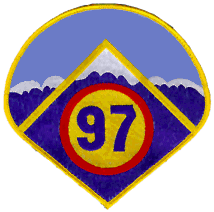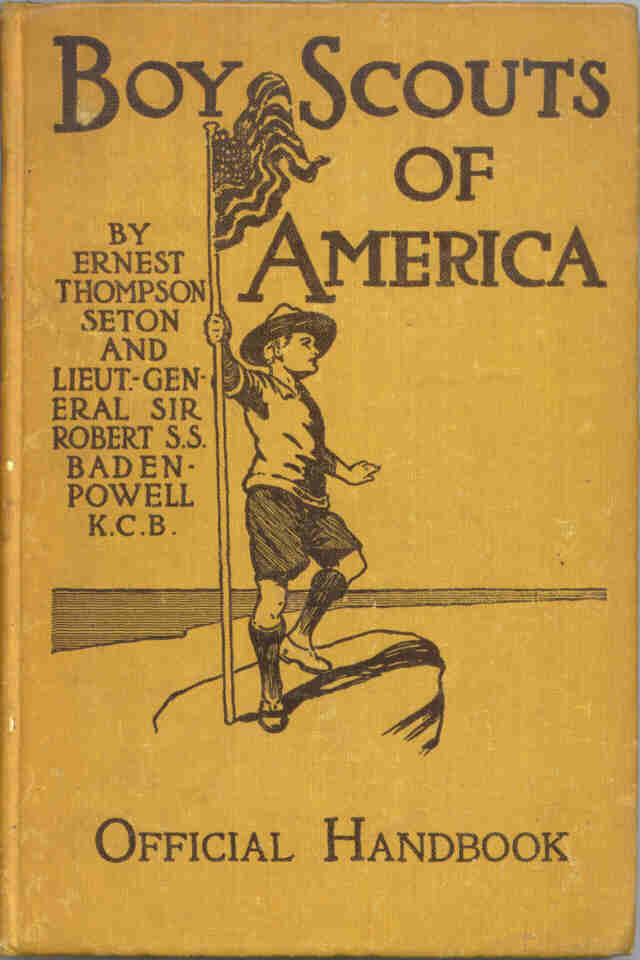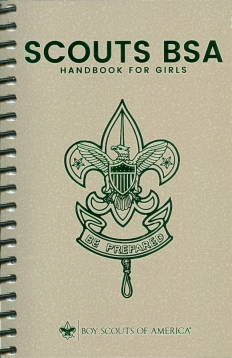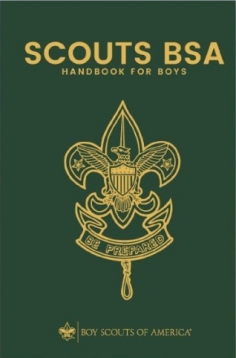Adventure! Troop 97
for boys & girls

Fort Collins,
Colorado USA
www.troop97.net
![]() HOME—BSA Handbooks & Handbook Covers—Scout Handbook
HOME—BSA Handbooks & Handbook Covers—Scout Handbook



A Comparison of the Contents from the 1910 "Original" Edition through today's Fourteenth Editions
A Monograph by Jeff Snowden
Scoutmaster, Troop 97 BSA
Sixth Edition, 2019
(5th Edition published 2016)
(4th Edition published 2009)
(3rd Edition published 1999)
(2nd Edition published 1990)
(1st Edition published 1980)
Copyright, 1980, 1990, 1999, 2009, 2016, 2019 by Jeff Snowden
Table of Contents
Introduction
The Boy Scouts of America (BSA) recognized from its founding the value of a comprehensive handbook for its members, publishing its first permanent Handbook in August, 1911. Even during the year it took to standardize the American program, the BSA hurriedly printed a temporary handbook, combining Chief Scout Ernest Thompson Seton's Birch-Bark Roll and Baden-Powell's Scouting for Boys. Since 1910, the BSA has published this one temporary Handbook edition (which they call the Original Edition) and fourteen permanent Handbook editions.
The Handbook has changed greatly since 1910, but much of the content of the early handbooks is still recognizable in today's edition. It is fascinating to examine the similarities and differences among the editions, what made each edition unique, and the trends that developed over the Handbook's history.
This sixth edition of the Handbook's story is an ongoing revision (now through about September 2019) to add the BSA's new Fourteenth Editions [plural], being released in February (for girls) and about September (for boys) 2019.
If you find any errors or have suggestions to improve this study, or if you'd like to share Scouting ideas, I'd like to hear from you. Please send me an e-mail!
Terminology
In this study, the term "BSA" stands for Boy Scouts of America and refers either to the organization's national headquarters or to its national staff. The term "Handbook" (with a capital 'H') always refers to the Scout Handbook.
Titles and Authors
Scout Handbooks often had three different titles: one on the title page, another on the cover, and yet another on the spine. Usually, the wording on the title page shows the most complete and accurate title, and that is the title used in this study. Until 1959, the Handbooks used some variation of the title Handbook for Boys. Then through 2018, they used some variation of the title Boy Scout Handbook or Scout Handbook. With the admission of girls as Scouts, the new 14th Editions are using Handbook for Boys AND Handbook for Girls.
Before 1959, each section of the Handbook was written by an expert in that field, sometimes a BSA employee and sometimes an outside expert. (Experts also contributed chapters to the Original Edition, though Seton and Baden-Powell wrote most of it.) A BSA editorial committee maintained full control over content and direction of all the permanent Handbooks, although this control was generally minimal and often careless through the first four editions (frequently allowing errors to go undetected for many years and sometimes allowing the contents of one section to contradict the contents of another section). Since 1959, a single author has written each Handbook (William "Green Bar Bill" Hillcourt and Robert Birkby each wrote three Editions).
Editions
Defining "edition" is not as easy as it might seem. You'd think a new edition would differ from a previous edition in major ways. But the BSA has changed editions three times without rewriting the Handbook. And sometimes, there have been greater changes between successive printings of the same edition than between two editions. The BSA says that, "Except for the first and second editions, changes in the requirements for advancement have been the primary reasons for changes in the editions of the Handbook." But advancement changes often produced only minor modifications. More recently, BSA practice has been to revise the Handbook about "every eight or nine years to include the latest information about Scouting and outdoor adventures."
As a result, the Handbook consists of only eleven truly different manuals divided into an Original Edition and fourteen permanent editions:
Distinguishing Early Editions
There are special problems in trying to distinguish the 1st through 4th Editions, because the BSA did not adopt the current system of edition numbering until 1948. At that time, they could have saved a lot of confusion by calling the new 1948 Handbook the 3rd Edition. Instead, they chose to call it the 5th Edition, even though the BSA had published only two truly different Handbooks prior to it.
From 1911 to 1927, the Handbook was entitled The Official Handbook for Boys, with printings numbered consecutively from 1 to 37 (plus two "reprints" and three "special" printings for a total of 42 printings). From 1927 to 1948, the title was Revised Handbook for Boys (most printings were confusingly entitled Revised Handbook for Boys, First Edition), with printings numbered from 1 to 39. Yet in 1948, the BSA retroactively divided these two manuals into four editions, and BSA records are unclear as to exactly where they intended to divide the first four editions.
As a result, neither collectors nor the BSA are sure where to divide the early editions. Most collectors agree that the "Second Edition" begins with the 11th printing (1914), when the cover picture changes and the cover first states "Revised Edition". Everyone agrees that the 1927 Handbook starts a new edition. And most collectors agree that the "Fourth Edition" begins with the 33rd printing (1940), which has a new cover and major content changes. Although BSA for many years split the first four editions differently, today's BSA publications put the splits where most collectors put them:
Printings
"Printing" refers to each separate printing run. This is not always as obvious as it sounds, since the BSA did not carefully identify early printings, sometimes called a printing a "reprint" of a previous printing, and called most early printings "editions." Especially in the Handbook's early years, there are frequent variations within a printing run, sometimes due to printer errors affecting only part of the run, sometimes due to last-minute corrections not made in all copies, and sometimes due to the fact that ads did not always appear in the full run. As a result, collectors often identify several variants for many printings.
Because of poor record keeping in the early years, and frequent printing overruns, nobody knows exactly how many Handbooks have been printed. Most of the Handbooks include a line showing a grand total of all the Handbooks printed since 1910, but this is a best guess that has been adjusted many times. One adjustment never reflected in other official BSA printing records was the addition of 785,000 copies apparently resulting from undocumented overruns of the 1927-1948 Handbook.
Until 1938, most printings were about 100,000 copies. Since 1938, only one printing has been less than 200,000, and most were 350,000 or more. The smallest printing run was only 5250 copies (December, 1911). The record for the largest single printing is 1.5 million (June, 1972, the first printing of the 8th Edition). The edition with the most copies in print is the 5th (6.4 million), although the related 6th/7th Editions have a combined total of 8.2 million, and the related 3rd/4th Editions (considered a single edition by some) have a combined total of 7.2 million. The editions with the fewest copies in print are the Original (68,900) and the 1st (313,500). [Note that since the release of the 13th Edition in 2016 the BSA has apparently stopped notating printings in its Handbooks.]
Materials
The vast majority of Handbook copies are soft cover, though most printings have included a small number of hardcover copies. Covers are usually heavy paper, though leather, vinyl, and oilcloth have been used, generally on limited-run books. Pages have always been some shade of off-white, and the typeface has usually been printed in black ink (except the 3rd Edition, which was printed entirely in green ink).
Bindings
Until about 1970, all Handbooks were bound using stitched signatures (the way most hardcover books are bound). Starting with the late printings of the 7th Edition (about 1971), the BSA has used the cheaper "perfect" binding, where each page is glued directly to the spine (like a pad of paper). As a result, modern Handbooks fall apart all too readily, given the rugged use most Scouts put them to. In recent years, a very practical, coil-bound version of the Handbook has been available, but at a higher price. Starting with later 13th Edition printings, only the coil-bound version is available.
Cover Art
Since 1910, the Handbooks have had 17 covers: two line drawings, a color sketch, a plain cover, four photo montages, and nine paintings. Only four covers were not full color (Original, 1st, early 8th, and 14th Editions).
Only two artists have contributed more than one cover. Don Ross (former BSA art director) apparently painted both covers for the 5th Edition. Norman Rockwell painted the covers for the 3rd, 4th, 6th, and 9th Editions. Interestingly, of the four Rockwell paintings, only the 6th Edition figure was specifically painted to be a Handbook cover; the other three were Brown & Bigelow annual Scout calendar pictures (Rockwell got his start working for Boys Life magazine).
All cover variants are included with the description for each Handbook Edition. I have not attempted to cover special commemorative editions or hardcover editions, but rather the standard softcover handbooks used by the Scouts.
Advertising
From 1911 through 1964, the BSA subsidized the cost of producing the Handbook by selling commercial advertising space in the Handbook. Since 1964, only the 1975/76 printings of the 8th Edition have contained ads.
Advertised products naturally have included camping-related equipment and food, sports equipment (from helmets to athletic supporters), and clothing (including shoes, sneakers, socks, and underwear). Foods have included chewing gum, sardines, Coca Cola, pancakes, shredded wheat, Lifesavers, chocolate, baking powder, baked beans, bouillon cubes, and dates. By far the most ads are for rifles and ammunition. Other promoted products have included outboard motors, cameras, bicycles and motor scooters, toy trains, watches, 3-in-One oil, Mercurochrome, and musical instruments.
A pre-1920 sampler of ads included: Minute tapioca, Excelsior shoes, Waltham watches, Kodak cameras, Steero bouillon cubes, Peters chocolate, BVD, Chiclets, and Heinz (baked beans & spaghetti). Ads from the 1960s included: Eveready batteries, Aunt Jemima pancakes, Lionel trains, Johnson and Evinrude outboard motors, Wrigley gum, Reynolds Wrap, and both Cushman and Harley-Davidson motor scooters.
Size
Actual Handbook dimensions are shown in the description of each Edition. Starting out somewhat smaller than today's Handbook, the Handbook became progressively smaller and thicker, reaching minimum size in 1944. Then the 6th Edition (1959) increased significantly in size. The 8th through 10th Editions were slightly smaller in width (but the 8th, 10th, and 13th Editions were the thickest handbooks, at 25 mm/1"). The 11th Edition is the tallest (though not the thickest) Handbook.
The type size in the Handbooks until 1959 was fairly small (about 8-point); since 1959, type size has been about 9-point (except the 8th Edition, which was a fairly large 11-point). Interestingly, the 12th & 13th Editions appear to have the smallest type size of any Handbook. [The "point" is a standard printers measure equal to about 1/72" (0.4 mm).]
Arrangement of Handbook Contents
The Handbooks arrange their subject matter in two broad ways: by rank or by subject (see Table Comparing the Contents of Every Edition [PDF file]).
Five editions (3rd, 4th, 6th, 7th, 11th) arrange their contents primarily by rank (Tenderfoot section, Second Class section, etc.). First aid information, for example, might be divided into three parts, one part appearing in the Tenderfoot section of the Handbook, one in the Second Class section, and one in the First Class section.
Nine editions (1st, 2nd, 5th, 8th, 9th, 10th, 12th, 13th, 14th, plus the Original Edition) arrange their contents primarily by subject area, with generally no direct relationship to the advancement requirements. Here, all first aid information would appear in only one place, even though it might be required for two or three ranks.
The 11th Edition actually does a little of both, having chapters for each rank, but also including chapters for first aid and other skills. Here, the chapters on each rank cover many of the skills for that rank, and provide page references for the more detailed sections elsewhere in the book.
The Most Common Subjects
The Table Comparing the Contents of Every Edition (PDF file) lists a broad range of Scouting subjects and shows which Handbook editions they appear in. Relatively few subjects are common to all fourteen editions, primarily:
Here is a list summarizing when some common subjects first appeared in the Handbook (though many of these subjects have long appeared elsewhere, such as in the Fieldbook and in merit badge pamphlets):
Sources of Old Handbooks
There are three main ways to find old Scout Handbooks. One is to frequent old/used book stores, which often have a special section for Scouting-related items. A second is to use one of the Scouting memorabilia dealers (who usually have a website with offerings listed; I found several by searching under the keywords "scouting memorabilia"). And a third is of course eBay.
Want to Know More?
One great source of BSA publication history from 1910 through about 1989 was called "Kahuna's Katalog of Boy Scouting Handbooks" by Eagle Scout & long-time Scouter Joe Price (1929-2002). It had over 300 pages of detailed information and cover photos of every printing of Boy Scouting handbooks. For those who want more info than our few web pages, I'm happy to tell you that Price's three 'Katalogs' covering Boy Scout and Cub Scout literature have recently (2021) been published and are available to buy from Amazon and from other publishers (just google 'Kahuna's Katalog') for about US$40 each [just FYI, I do NOT receive any payment for mentioning these books].

Last Revision to This Page: 4 July 2024
Text copyright © 1980, 1990, 1999, 2009, 2016, 2019 by Jeff Snowden
Web format © 1996-2024 by Troop 97 BSA
Handbook pictures copyright © by Boy Scouts of America